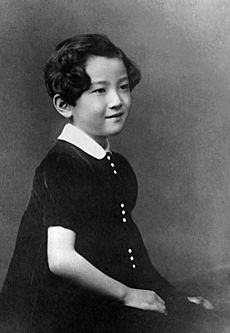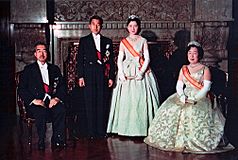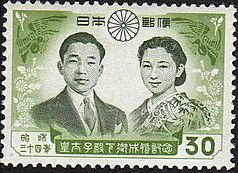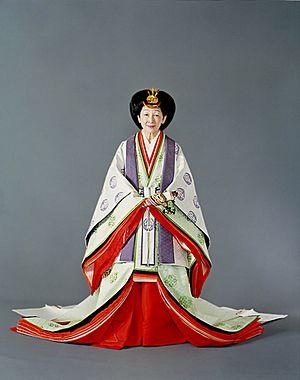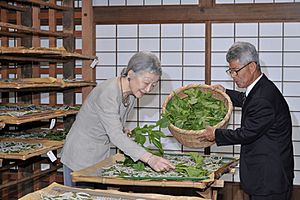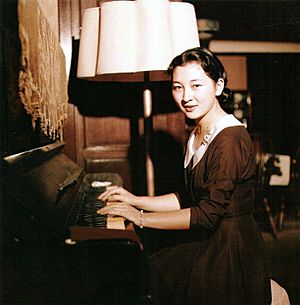Empress Michiko facts for kids
Quick facts for kids Michiko
|
|
|---|---|
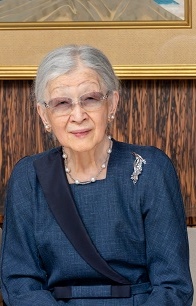
Michiko in 2024
|
|
| Empress consort of Japan | |
| Tenure | 7 January 1989 – 30 April 2019 |
| Enthronement | 12 November 1990 |
| Born | Michiko Shōda (正田 美智子) 20 October 1934 Bunkyō, Tokyo, Japan |
| Spouse | |
| Issue |
|
| House | Imperial House of Japan |
| Father | Hidesaburō Shōda |
| Mother | Fumiko Soejima |
| Religion | Shinto |
Michiko (美智子, born Michiko Shōda [正田 美智子 Shōda Michiko], 20 October 1934) is a member of the Imperial House of Japan. She was the Empress of Japan as the wife of Akihito. Akihito was the 125th Emperor of Japan. He reigned from January 7, 1989, to April 30, 2019.
Michiko married Crown Prince Akihito in 1959. She became the Crown Princess of Japan. She was the first person from a regular family, called a commoner, to marry into the Japanese imperial family. She and Akihito have three children: Naruhito, Fumihito, and Sayako. Her oldest son, Naruhito, is the current emperor. As Crown Princess and later as Empress, she traveled widely. She became the most visible imperial consort in Japan's history. When Akihito stepped down from his role in 2019, Michiko received the new title of Jōkōgō (上皇后), or Empress Emerita.
Contents
Early Life and School Days
Michiko Shōda was born on October 20, 1934. She was born at the University of Tokyo Hospital in Bunkyō, Tokyo. She was the second of four children. Her father, Hidesaburō Shōda (正田英三郎), was the head of Nisshin Flour Milling Company. Her mother was Fumiko Soejima. Michiko grew up in Tokyo in a family that valued culture. She received a careful education. She learned English and how to play the piano. She also learned about arts like painting and cooking.
Michiko attended Futaba Elementary School in Kōjimachi. She had to leave in fourth grade because of American bombings during World War II. She then studied in different areas like Kanagawa and Gunma. She returned to Tokyo in 1946. She finished elementary school and then attended the Sacred Heart School for junior high and high school. She graduated from high school in 1953.
In 1957, Michiko graduated with top honors from the University of the Sacred Heart in Tokyo. She earned a degree in English literature.
Meeting and Marriage
In August 1957, Michiko met Crown Prince Akihito. They met on a tennis court in Karuizawa. The Imperial Household Council officially approved their engagement on November 27, 1958. The news was seen as a "fairy tale" by the media. The engagement ceremony happened on January 14, 1959.
Michiko was the daughter of a wealthy businessman. But she was still a commoner. Many people expected the Crown Prince to marry someone from a noble family. Some traditional people did not like the engagement. This was because Michiko came from a family with Catholic ties. Even though she was not baptized, she went to Catholic schools.
However, the young couple had a lot of public support. People liked "Mitchy," as she was called. She became a symbol of Japan's modern changes. The wedding took place as a traditional Shinto ceremony on April 10, 1959. Over 500,000 people watched the wedding procession in Tokyo. Parts of the wedding were shown on TV. This was the first imperial wedding to be seen by the public in Japan. About 15 million people watched it. When she joined the imperial family, Michiko received a personal symbol. It was the white birch of Japan.
Life as Crown Princess
The young couple moved to Tōgū Palace (東宮御所), or "East Palace." This was the official home of the crown prince. It is located in the Akasaka Estate in Tokyo. They lived there until Akihito became emperor in 1989.
The couple had three children:
- Naruhito, Prince Hiro (浩宮徳仁親王, born February 23, 1960, in Tokyo)
- Fumihito, Prince Aya (礼宮文仁親王, born November 30, 1965, in Tokyo)
- Sayako, Princess Nori (紀宮清子内親王, born April 18, 1969, in Tokyo). After marrying Yoshiki Kuroda on November 15, 2005, Princess Nori gave up her imperial title. She left the Imperial Family as required by law. She took her husband's last name and became known as "Sayako Kuroda" (黒田清子).
Unlike old traditions, Crown Prince Akihito and Crown Princess Michiko chose to raise their children themselves. They did not leave them with private tutors. The Crown Princess even breastfed her children. She and her husband became very popular with the public. They often traveled to all 47 prefectures of Japan to meet people. They also made the imperial family more open. Between 1959 and 1989, the Crown Prince and Princess visited 37 foreign countries.
Empress of Japan
When Emperor Shōwa passed away on January 7, 1989, Michiko's husband became the 125th Emperor of Japan. She became the empress consort. The new Emperor and Empress had their official enthronement ceremony. It took place at the Tokyo Imperial Palace on November 12, 1990.
After becoming Empress, Michiko and her husband visited many countries. They helped make the Imperial Family more visible and friendly in modern Japan. They also tried to be close to the people. They visited all 47 prefectures of Japan.
Her official duties included helping her husband at events and ceremonies. She also welcomed official guests, including leaders from other countries. She visited social, cultural, and charity organizations. For example, in 2007, Michiko carried out official duties over 300 times. For many years, Akihito and Michiko visited places for children on Children's Day. They also visited places for the elderly on Respect for the Aged Day. After her mother-in-law, Empress Dowager Nagako, passed away in 2000, Michiko became the honorary president of the Japanese Red Cross Society.
As Empress, she was in charge of Momijiyama Imperial Cocoonery. This is a sericulture farm on the imperial palace grounds. She took part in the yearly silk harvesting ceremony. She personally fed silkworms with mulberry leaves. She also took care of them and the silk production. Making and harvesting silk was part of her duties. These duties are connected to Shintoism, Japanese culture, and tradition. From 1994 to 2019, the Empress gave some of the harvested silk to the Shōsōin Treasure-house. This silk was used to help restore its treasures.
The Empress of Japan is expected to show traditional values like modesty and purity. Michiko always showed a strong sense of duty. This made her very popular among the Japanese people. She took part in religious ceremonies with her husband. They visited Ise Grand Shrine and other Shinto shrines. They also visited Imperial tombs to pray to their ancestors. Michiko is also a talented classical pianist.
When her husband stepped down on April 30, 2019, she became the Empress Emerita. Since then, the couple's main home has been the Takanawa Residence. In August 2023, Michiko and Akihito visited the tennis court where they first met. They talked with people who help take care of the court.
Hobbies and Interests
The Empress Emerita enjoys reading and music. She plays the piano and harp. The imperial family has sometimes played music together as a piano trio. Crown Prince Akihito played the cello, Crown Princess Michiko played the piano, and Prince Naruhito played the violin. Empress Michiko also likes gagaku, which is a type of traditional Japanese court music.
She also loves poetry. She has chosen, put together, and translated poems by Michio Mado. These were published in collections like Dobutsu-tachi (Animals) in 1992 and Fushigi na Poketto (The Magic Pocket) in 1998.
She has written several poems, including waka. Some of her poems have been published. A collection of 367 waka by the Empress was published in 1997. It was called Seoto (瀬音, The Sound Current). Some of these poems were translated into French.
In 1991, she wrote a children's book. It was called Hajimete no Yamanobori ("My First Mountain Climb").
Health Updates
Michiko has faced some health challenges. She had nervous breakdowns due to pressure. In the 1960s, she lost her voice for seven months. In 1993, she briefly collapsed on her birthday. She did not speak for two months. Doctors said this was due to "deep sadness" from negative media stories.
In 2007, Empress Michiko had to cancel many duties. She had mouth ulcers, nosebleeds, and internal bleeding. Doctors said this was due to psychological stress.
In June 2019, it was announced that Michiko had heart valve issues. She also had an irregular pulse. She was well enough for cataract operations. In August 2019, she was diagnosed with early-stage breast cancer. She had surgery to remove it in September 2019, which was successful. On her 86th birthday in October 2020, it was shared that she had a mild fever since May. In August 2022, she was diagnosed with deep vein thrombosis. This was after a clot was found in her right calf.
On June 3, 2024, Michiko tested positive for COVID-19. She recovered after one week.
On October 7, 2024, she had surgery after breaking her femur. This happened during a fall at the Sentō Imperial Palace in Tokyo. The surgery was successful.
Children
Michiko and Akihito have three children: two sons and one daughter.
| Name | Birth | Marriage | Children | |
|---|---|---|---|---|
| Date | Spouse | |||
| Naruhito, Emperor of Japan (Naruhito, Prince Hiro) |
23 February 1960 | June 9, 1993 | Masako Owada | Aiko, Princess Toshi |
| Fumihito, Crown Prince of Japan (Fumihito, Prince Aya) |
30 November 1965 | June 29, 1990 | Kiko Kawashima |
|
| Sayako Kuroda (Sayako, Princess Nori) |
18 April 1969 | November 15, 2005 | Yoshiki Kuroda | None |
Titles and Honours
Titles and Styles
- April 10, 1959 – January 7, 1989: Her Imperial Highness The Crown Princess (皇太子妃殿下 Kōtaishi-hi Denka)
- January 7, 1989 – April 30, 2019: Her Majesty The Empress (皇后陛下 Kōgō Heika)
- May 1, 2019 – present: Her Majesty The Empress Emerita (上皇后陛下 Jōkōgō Heika)
Honours from Other Countries
 Austria: Grand Star of the Decoration for Services to the Republic of Austria
Austria: Grand Star of the Decoration for Services to the Republic of Austria Belgium: Grand Cordon of the Order of Leopold I
Belgium: Grand Cordon of the Order of Leopold I Denmark: Knight of the Order of the Elephant
Denmark: Knight of the Order of the Elephant France: Grand Cross of the National Order of Merit
France: Grand Cross of the National Order of Merit Germany: Grand Cross Special Class of the Order of Merit of the Federal Republic of Germany
Germany: Grand Cross Special Class of the Order of Merit of the Federal Republic of Germany Indonesia: Star of Mahaputera, 1st Class
Indonesia: Star of Mahaputera, 1st Class Nepalese Royal Family:
Nepalese Royal Family:
- Member of the Order of the Benevolent Ruler
 Netherlands: Knight Grand Cross of the Order of the Netherlands Lion
Netherlands: Knight Grand Cross of the Order of the Netherlands Lion Norway: Grand Cross of the Royal Norwegian Order of Saint Olav
Norway: Grand Cross of the Royal Norwegian Order of Saint Olav Philippines: Member of the Order of Gabriela Silang
Philippines: Member of the Order of Gabriela Silang Poland: Knight of the Order of the White Eagle
Poland: Knight of the Order of the White Eagle Portugal:
Portugal:
- Grand Cross of the Military Order of Saint James of the Sword
- Grand Cross of the Order of Prince Henry
 Spain:
Spain:
- Dame Grand Cross of the Royal and Distinguished Spanish Order of Charles III
- Dame Grand Cross of the Royal Order of Isabella the Catholic
 Sweden: Knight of the Royal Order of the Seraphim
Sweden: Knight of the Royal Order of the Seraphim Thailand:
Thailand:
- Dame of the Most Illustrious Order of the Royal House of Chakri
Honorary Positions
- Honorary president of the Japanese Red Cross Society (this role was later passed to her daughter-in-law Masako)
See also
 In Spanish: Michiko para niños
In Spanish: Michiko para niños


